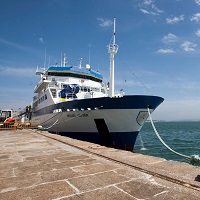Contact for the resource
IEO/ Santander Oceanographic Centre
321 record(s)
Type of resources
Categories
Topics
INSPIRE themes
Keywords
Contact for the resource
Provided by
Years
Formats
Status
-

Abundance indices, distribution patterns and faunal assemblages of demersal species in the Porcupine bank, together with the possible driving factors of their distributio
-

Abundance indices, distribution patterns and faunal assemblages of demersal species in the Porcupine bank, together with the possible driving factors of their distribution. This survey belongs to the research project: 'Evaluación de Recursos Demersales por Métodos Directos en el Área ICES'. This Project is partly funded by the DCR of the EU and the Science and Innovation Spanish Ministry.The main objectives of the above mentioned project related with this survey time series are: a) to obtain abundance indices of the main exploited species in the Porcupine bank; b) to estimate the strength of yearly recruitments of these species and their distribution in the bank. c) to study the structure and distribution o the demersal and benthic communities in the area.
-

The objective of the project RADIALES, formulated in 1990, aims at “understanding and modelling the response of the marine ecosystem to the sources of temporal variability in oceanographic and planktonic components, particularly foccusing in those factors and processes affecting biological production and potentially altering the ecosystem services”. This project represents the oldest multidisciplinary ocean observation initiative still active in Spain.
-

The objective of the project RADIALES, formulated in 1990, aims at “understanding and modelling the response of the marine ecosystem to the sources of temporal variability in oceanographic and planktonic components, particularly foccusing in those factors and processes affecting biological production and potentially altering the ecosystem services”. This project represents the oldest multidisciplinary ocean observation initiative still active in Spain.
-

The objective of the project RADIALES, formulated in 1990, aims at “understanding and modelling the response of the marine ecosystem to the sources of temporal variability in oceanographic and planktonic components, particularly foccusing in those factors and processes affecting biological production and potentially altering the ecosystem services”. This project represents the oldest multidisciplinary ocean observation initiative still active in Spain.
-

Getting the spatial distribution and abundance indices of benthic and demersal fauna of the continental shelf of Galicia and Cantabrian Sea. Hydrographic survey of the neritic zone led to its influence on the distribution of species. Sampling using a box corer to obtain granulometrics indices of sediment.
-

Getting the spatial distribution and abundance indices of benthic and demersal fauna of the continental shelf of Galicia and Cantabrian Sea. Hydrographic survey of the neritic zone led to its influence on the distribution of species. Sampling using a box corer to obtain granulometrics indices of sediment.
-

Getting the spatial distribution and abundance indices of benthic and demersal fauna of the continental shelf of Galicia and Cantabrian Sea. Hydrographic survey of the neritic zone led to its influence on the distribution of species. Sampling using a box corer to obtain granulometrics indices of sediment.
-

Getting the spatial distribution and abundance indices of benthic and demersal fauna of the continental shelf of Galicia and Cantabrian Sea. Hydrographic survey of the neritic zone led to its influence on the distribution of species. Sampling using a box corer to obtain granulometrics indices of sediment.
-

Getting the spatial distribution and abundance indices of benthic and demersal fauna of the continental shelf of Galicia and Cantabrian Sea. Hydrographic survey of the neritic zone led to its influence on the distribution of species. Sampling using a box corer to obtain granulometrics indices of sediment.
 Catálogo de datos del IEO
Catálogo de datos del IEO